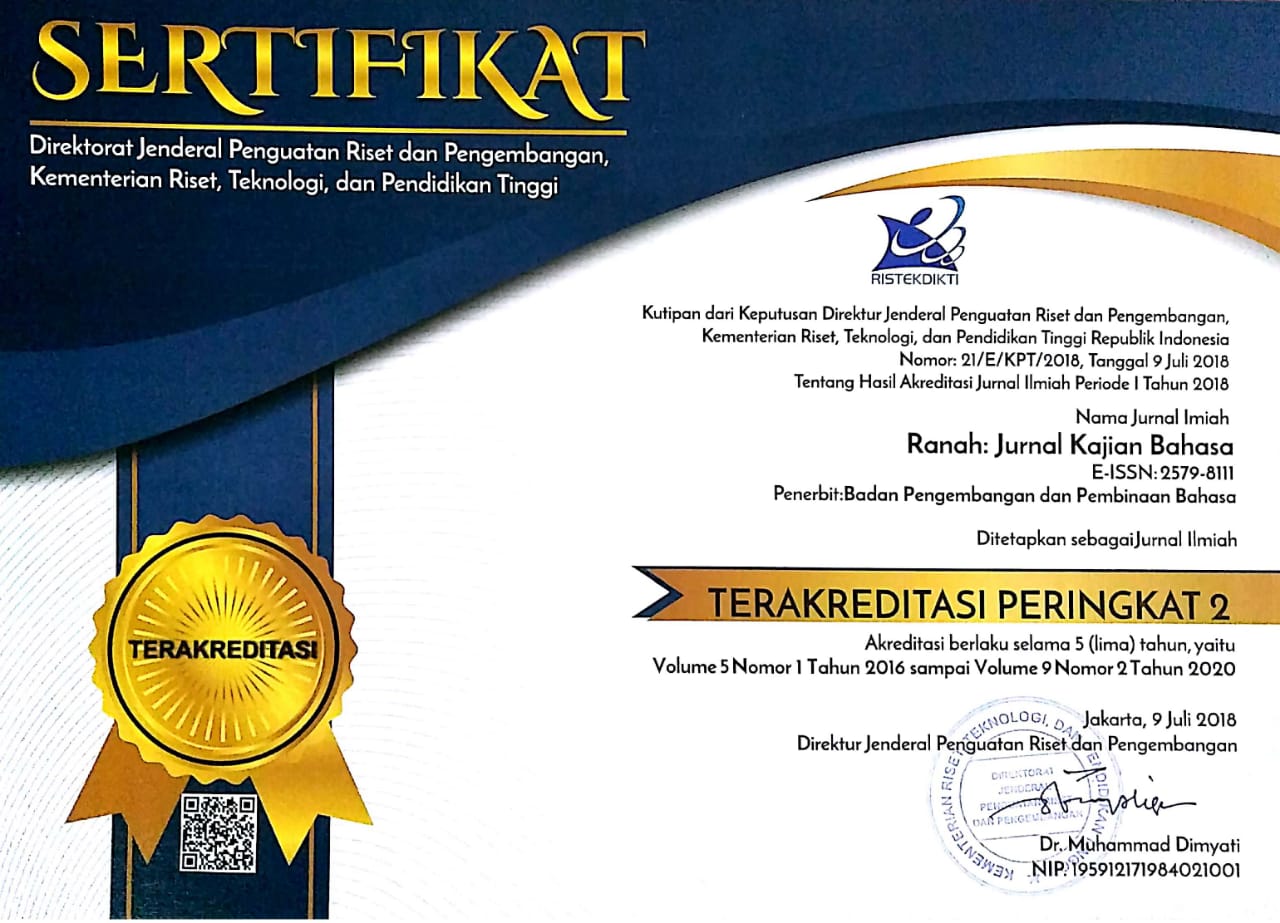Figur Remaja Pendukung Nazi dalam Film Lore: Perkembangan Identitas Remaja dan Pergerakan Posisi Korban-Pelaku
Abstract
The involvement of a child in a case which put them in the position of victim or perpetrator needs to be reviewed through their identity development. One of the cases that discussed the issue about victim and perpetrator was the postwar situation when the Nazi regime collapsed on the end of World War II. Lore (2012) by Cate Shortland became one of the movies that took time on postwar situation and bringing up the issue of victim or perpetrator through the perspective of adolescent. The subject of this study is the identification of the Nazi supporter adolescent’s position as victim or perpetrator that is depicted in the movie Lore. The method used in this study is qualitative method with the main theory of Alterität und Identität by Wolfgang Raible and the adolescent identity status theory by James Marcia. The theory of Alterität und Identität is used to analyze how the main character interacts with foreign things she encounters in the postwar period and its influence on her identity awareness. The identification of the character’s position as victim or perpetrator on postwar context in the movie Lore was carried out using the status of adolescent identity theory. The result of this analysis shows that there is a development of identity experienced by the character Lore, so that the movie depicts her as a victim based on the adolescent identity development.
Abstrak
Keterlibatan seorang anak dalam suatu kasus yang memposisikannya sebagai korban atau pelaku perlu ditinjau melalui perkembangan identitasnya. Salah satu kasus yang mengangkat isu tentang korban dan pelaku adalah keadaan setelah perang ketika rezim Nazi runtuh pada akhir Perang Dunia II. Film Lore (2012) karya sutradara Cate Shortland menjadi salah satu film yang berlatarkan setelah perang dan mengangkat isu korban dan pelaku melalui perspektif remaja. Hal yang menjadi pembahasan dalam penelitian ini adalah identifikasi posisi remaja pendukung Nazi sebagai korban atau pelaku yang digambarkan dalam film Lore. Metode yang digunakan dalam penelitian ini adalah metode kualitatif dengan teori Alterität und Identität (Perbedaan dan Identitas) milik Wolfgang Raible dan teori status identitas remaja milik James Marcia. Teori Alterität und Identität digunakan untuk menganalisis bagaimana interaksi tokoh utama dengan hal-hal asing yang ditemuinya pada masa setelah perang dan pengaruhnya terhadap kesadaran identitas. Identifikasi penggambaran posisi tokoh sebagai korban atau pelaku dalam konteks setelah perang dilakukan menggunakan teori psikologi mengenai status identitas remaja. Hasil dari analisis menunjukkan terdapat perkembangan identitas yang dialami oleh tokoh Lore, sehingga posisinya digambarkan di dalam film ini sebagai korban berdasarkan perkembangan identitas remaja.
Keywords
Full Text:
PDF (Bahasa Indonesia)References
Alfitrah, M. H. ( 2021). Perlindungan Hukum Terhadap Anak Sebagai Pelaku Tindak Pidana Terorisme Perspektif Hukum Positif Dan Hukum Islam. Skripsi Uin Jakarta.
"Anti-Jewish Laws Timeline", Montreal Holocaust Museum.(n.d). Diunduh dari https://museeholocauste.ca/app/uploads/2019/03/anti_jewish_laws_timeline.pdf.
Bartoletti, S.C. (2005 ). Hitler Youth: Growing Up in Hitler's Shadow: Growing Up in Hitler's Shadow. Scholastic Inc.
Biesinger, J. A. (2006). Germany: A reference guide from the renaissance to the present. Facts on File.
Biro Hukum dan Humas Kemenpppa. (n.d)."Masyarakat dan Anak Bergerak Bersama Melindungi Anak Korban Terorisme". Diunduh dari https://www.kemenpppa.go.id/index.php/page/read/29/3143/masyarakat-dan-anak-bergerak-bersama-lindungi-anak-korban-terorisme
Children and Crime. (nd). Diunduh dari https://eprints.leedsbeckett.ac.uk/id/eprint/6773/1/ChildrenAndCrimeAM-WEBSTER.pdf
"George Ehrman's Yellow Star: A symbol of discrimination against Jews and of the holocaust." (n.d.). Montreal Holocaust Museum. Diakses pada 15 Mei 2019 dari https://museeholocauste.ca/en/objects/george-ehrmans-yellow-star/
Hakim, A. (2018). "Keluarga terduga teroris gemparkan Surabaya." Antara News. Diakses pada 10 April 2019 dari https://www.antaranews.com/berita/709488/keluarga-terduga-teroris-gemparkan-surabaya
Kroger, J. (2004). Identity in adolescence the balance between self and other (edisi ketiga). Routledge.
Lury, K. (2010). The Child in Film: Tears, Fears, and Fairy Tales. Rutgers University Press. https://doi.org/10.5040/9780755697502
McLeod, S. (2018). Erik Erikson's Stages of Psychosocial Development. Diunduh dari https://www.simplypsychology.org/Erik-Erikson.html
Marcia, J. E. (1966). Development and validation of ego-identity status. Journal of Personality and Social Psychology, 3(5), 551-558. https://doi.org/10.1037/h0023281
Marcia, J. E., Waterman, A. S., Matteson, D. S., Archer, S. L., & Orlofsky, J. L. (1993). Ego identity: A handbook for psychological research. Springer-Verlag. https://doi.org/10.1007/978-1-4613-8330-7
Moleong, L. J. (2014). Metodologi penelitian kualitatif (edisi 32). PT Remaja Rosdakarya.
Pinfold, D. (2015). The sins of the fathers: Mark Herman's The Boy in the Striped Pyjamas (2008) and Cate Shortland's Lore (2012). Oxford German Studies, 44(3), 254-270. https://doi.org/10.1179/0078719115Z.00000000086
Pollin-Galay, H. (2018).'The Victim-Perpetrator Encounter'. Ecologies of Witnessing: Language, Place, and Holocaust Testimony. (New Haven, CT. online edn, Yale Scholarship Online, 23 May 2019), https://doi.org/10.12987/yale/9780300226041.003.0004,
Purwastuti, Lilik. (2011 )."Perlindungan Hukum Terhadap Anak dalam Kejahatan Terorisme". Jurnal Ilmu Hukum Jambi, vol. 2, no. 3, 2011.
Raible, W. (1998). Alterität und identität. Zeitschrift Für Literaturwissenschaft Und Linguistik, 28(2), 7-22. https://doi.org/10.1007/BF03379114
Semedhi, B. (2011). Sinematografi-videografi: Suatu pengantar. Penerbit Ghalia Indonesia.
Smith, M. (1995). Engaging Characters: Fiction, Emotion, and the Cinema. Clarendon Press
Tollmann, K. (n.d.). "LORE." Diakses pada 5 April 2019 dari http://www.lore-der-film.de/film.php
United States Holocaust Memorial Museum. (2019). "Tattoos and numbers: The system of identifying prisoners at Auschwitz." Diakses pada 15 Mei 2019 dari https://encyclopedia.ushmm.org/content/en/article/tattoos-and-numbers-the-system-of-identifying-prisoners-at-auschwitz
Ward, E. M. (2017). Dismantling the third reich in Cate Shortland's Lore (2012). Film & History, 47(1), 18-27. https://remote-lib.ui.ac.id:2155/docview/2036371941?accountid=17242
Weinberg, G.L. (2012). Germany, Hilter, and World War II. Essay in Modern German and World History. Cambridge University Press. https://doi.org/10.1017/CBO9780511665172
Wieland-Burston, J. (2012). Holocaust victims and perpetrators. The Journal of analytical psychology, 57(4), 413-424. https://doi.org/10.1111/j.1468-5922.2012.01983.x
Yosevin, P. & Anwar, U. (2022). "Anak Terorisme Dalam Perspektif Perlindungan Anak". Jurnal Pendidikan Kewarganegaraan Undiksha Vol. 10 No. 2 (Mei, 2022) Open Access at : https://ejournal.undiksha.ac.id/index.php/JJPP
DOI: https://doi.org/10.26499/jentera.v11i2.1754
Refbacks
- There are currently no refbacks.






















